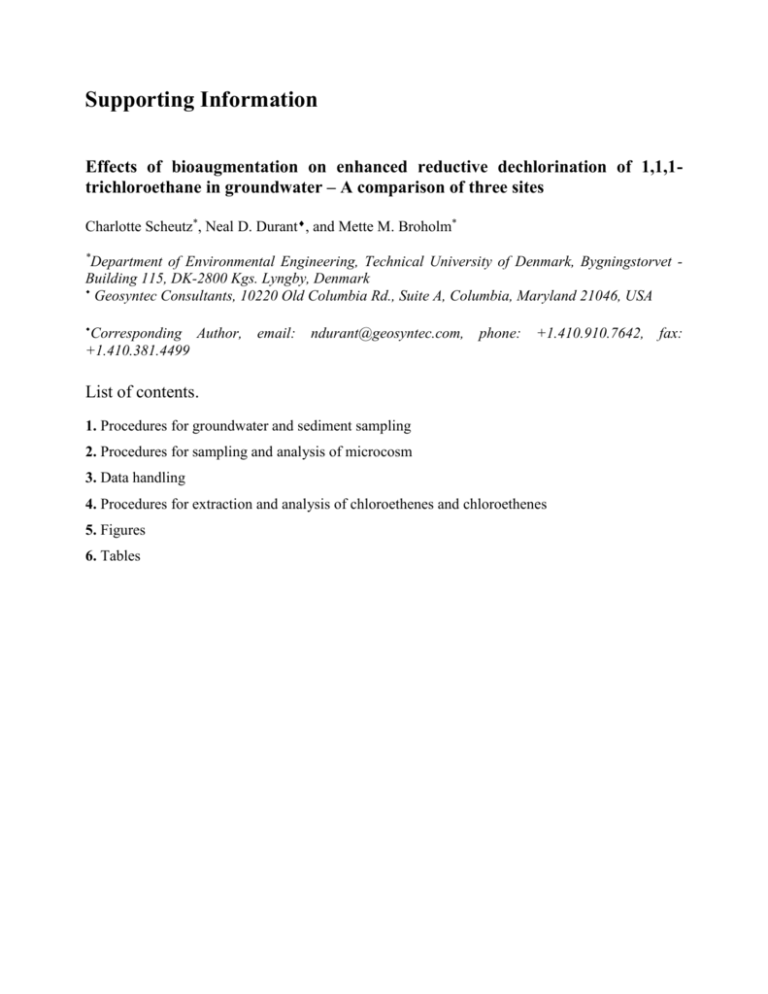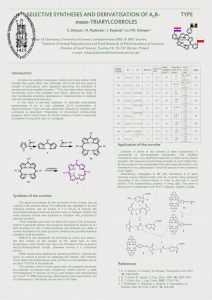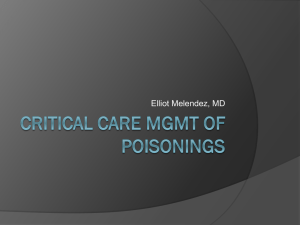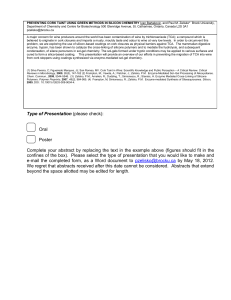A comparison of three sites - Springer Static Content Server
advertisement

Supporting Information Effects of bioaugmentation on enhanced reductive dechlorination of 1,1,1trichloroethane in groundwater – A comparison of three sites Charlotte Scheutz*, Neal D. Durant, and Mette M. Broholm* * Department of Environmental Engineering, Technical University of Denmark, Bygningstorvet Building 115, DK-2800 Kgs. Lyngby, Denmark Geosyntec Consultants, 10220 Old Columbia Rd., Suite A, Columbia, Maryland 21046, USA Corresponding Author, email: +1.410.381.4499 ndurant@geosyntec.com, phone: +1.410.910.7642, fax: List of contents. 1. Procedures for groundwater and sediment sampling 2. Procedures for sampling and analysis of microcosm 3. Data handling 4. Procedures for extraction and analysis of chloroethenes and chloroethenes 5. Figures 6. Tables 1. Procedures for groundwater and sediment sampling Groundwater was collected from wells screened in the clayey till and the underlying sand aquifers in autoclaved blue-cap glass-bottles under nitrogen flush, capped and stored at 4C until microcosms were set-up. Samples were collected using a peristaltic pump with dedicated tubing. Two well and gravel pack volumes were purged from each well and purge stabilization parameters (pH, temperature, oxidation reduction potential [ORP], dissolved oxygen [DO]) were monitored via an in-line flow-through cell (WTW-electrodes and instruments, Fagerberg, Brøndby, Denmark) prior to collection. Sediment cores from the clayey till and underlying sand aquifers were collected immediately adjacent to these wells using direct push technology (i.e., GeoProbe®) coring. The sediment cores were sampled in plastic core-barrels, capped under nitrogen flush, and transferred to nitrogen-filled, diffusion-tight aluminum bags, sealed and stored at 4C until microcosms were constructed. 2. Procedures for sampling and analysis of microcosm All microcosms were incubated upside down at 10°C for 600 days, and sampled periodically to analyze for donor consumption, (non-volatile organic carbon [NVOC], lactate, acetate, propionate, formate), redox conditions (NO3-, SO42-, dissolved Fe, methane) and degradation of chlorinated ethanes and ethenes (TCE, cDCE, tDCE, 1,1-DCE, VC, ethene, ethane, TCA, 1,1-DCA, CA). Prior to each sampling event, the bottles were shaken, weighed (to account for water and headspace volume changes) and left for sediment to settle. Samples were collected with sterile syringe and needle through the rubber stopper after volume compensation with sterile filtered nitrogen to prevent vacuum build up in batch flasks. Samples for the determination of chloroethenes, chloroethenes (1,1,1-TCA, 1,1-DCA and CA), ethene and ethane were analyzed with an Agilent 6890N gas chromatograph (GC) equipped with an Agilent 5973 mass spectrometer (MS). Aqueous samples (1 mL) were injected into sealed vials, acidified (with 0.5 mL 4% H2SO4), heated to 80oC, and the headspace was sampled and injected via autosampler into the GC. Separation was performed on a 25.0 m 320 µm 1.00 µm (nominal) capillary column (J&W GSQ) with helium (class 2) as carrier gas. Chloroform was used as internal standard (0.5 mL of a 10 ppmv aqueous solution). Detection limits for the chlorinated ethenes/ethanes and ethene were below 1 µg L-1 whereas for ethane it was 2.6 µg L-1. Samples for analysis of short-chained organic acids (lactate, acetate, formate, and propionate) were filtered through 0.45 µm nylon filter membrane acidified with 50 µL 17% H3PO4 per mL of sample, and frozen until analysis by suppressed ion chromatography (IC) using a Dionex IonPac ICE AS1 (9 250 mm) ion exclusion column, Dionex AMMS ICE II suppressor, and WATERS 432 conductivity detector (eluent: 4 mM heptafluorobutyric acid in 2% vol isopropanol; chemical suppression: 5 mM tetrabutyl ammonium hydroxide). Detection limits for the short-chained organic acids were below 0.01 mM. Anions were analyzed by IC (Dionex DX-120) using a two column set-up (Dionex Ion Pac AS14 (4 250 mm) column and an AG 14 (4 250 mm) column) with 3.5 mM Na2CO3 / 1 mM NaHCO3 as eluent. Detection limits for anions were below 0.2 mg L-1. Samples for analysis of cations (iron) were filtered through 0.45 µm nylon filters, acidified with 1M HNO3 (4 drops per 20 mL sample), refrigerated at 4 oC until analysis, and analyzed by atomic absorption (Perkin Elmer Instruments Analyst 200 AAS 5000) with flame detection at wavelengths of 248.33 nm for iron. Detection limit was below 0.01 mM. Headspace samples (200 µL) for analysis of methane were injected manually as direct oncolumn injections into a Shimadzu 14A GC equipped with a packed column (3% SP1500 Carbopack B) and a flame ionization detector. Methane was analyzed with an isothermal column temperature of 100 °C. The detection limit was 0.003 mM. The headspace methane concentrations were converted to aqueous concentrations by using Henry’s law (Syracuse Research Corporation Environmental Science PhysProp Database: http://www.syrres.com/esc/physdemo.htm. (Accessed April 2012). 3. Data handling The aqueous concentrations determined on aqueous samples from the microcosms were corrected based on Henry’s law to include the mass of the compounds in the headspace of the microcosms in order to account for changes in the aqueous to gas volume ratio caused by sampling. Aqueous concentrations were not corrected to account for sorption to or desorption from the sediment. As such, a portion of the concentration changes in the microcosms, particularly in the sterile controls, was attributed to sorption/desorption processes (e.g., increases in the aqueous concentration of compounds not added but initially present were attributed to the presence of a sorbed phase). As dechlorination daughter products are less hydrophobic than the parent compounds this can lead to increasing total molar concentrations in the aqueous phase over time as the parent compounds degrade. 4. Procedures for extraction and analysis of chloroethenes and chloroethenes After completion of the incubation experiments by Day 601, the total mass (sorbed, dissolved in water and in gas phase) of chloroethanes (TCA, 1,1-DCA) and chloroethenes (PCE, TCE, cDCE and 1,1-DCE) was quantified in selected batches by solvent extraction (in pentane) and analysis (GC-ECD) of the extract. CA, VC, ethene and ethane could not be quantified by this method, due to their lower boiling point preventing chromatographic separation. Sorption of these constituents was considered negligible, however, as they have high vapor pressure and are gases at the experiment temperature. Pentane (50 mL) added an internal standard (bromotrichloromethane 10 mg/L) was injected through the septum to each individual batch and shaken for 24 hours in a rotary box. The pentane phase was extracted through the septum and transferred to glass tubes with Teflon coated screw caps. If needed samples were diluted with pentane. The extracts were analyzed with a Shimadzo GC 2010 gas chromatograph equipped with an electron capture detector (Nuclide 63Ni Quantity 370 MBq 10Ci). Extract samples (1 µL) were injected via autosampler into the GC. Separation was performed on a 30.0 m 0.53 mm 3.00 µm capillary column (VocolTM, 11389-03B) with nitrogen as carrier gas. The temperature program was as followed: initial temperature: 45.0 ºC (1 min), temperature rate: 30.0 ºC/min (3.5 min), finale temperature 150 ºC (5.5 min). Detection limits for the chlorinated ethenes/ethanes were 0.15 µg L-1. 5. Figures Fig. SI 1 - Trends in aqueous phase chloroethanes, redox parameters, and electron donor in Høje Tåstrupvej source zone microcosms. First column; intrinsic control; second column; lactate-amended; and third column; lactate and bioaugmented. Batch abbreviations refer to the microcosm set-up presented in Table 2 in the paper. Fig. SI 2 - Trends in aqueous phase chloroethanes and chloroethenes in Høje Tåstrupvej source area microcosms. First column; intrinsic control; second column; lactate-amended; and third column; lactate and bioaugmented. Batch abbreviations refer to the microcosm set-up presented in Table 2 in the paper. Fig. SI 3 - Total mass of chloroethanes and 1,1-DCE (extracted in pentane) compared to total mass quantified in the aqueous and gas phase based on water and headspace analysis in source area Høje Tåstrupvej microcosms. The difference between the bars represents the mass sorbed to the sediment. Batch abbreviations refer to the microcosm set-up presented in Table 2 in the paper. Note that the mass of CA is not included as CA cannot be extracted into pentane due to the lower boiling point of CA in comparison to pentane. Also please note that during autoclaving of the sterile controls 1,1,1-TCA sorbed to the contaminated sediment were abiotically transformed to 1,1-DCE. Fig. SI 4 - Trends in aqueous phase chloroethanes, chloroethenes, redox parameters, and electron donor in Vadsbyvej source area microcosms. First column; intrinsic control; second column; lactate-amended; and third column; lactate and bioaugmented. Batch abbreviations refer to the microcosm set-up presented in Table 2 in the paper. Fig. SI 5 - Total mass of chloroethanes and c-DCE (extracted in pentane) compared to total mass quantified in the aqueous and gas phase based on water and headspace analysis in Vadsbyvej source area microcosms. The difference between the bars represents the mass sorbed to the sediment. Batch abbreviations refer to the microcosm set-up presented in Table 2 in the paper. Note that the mass of CA is not included as CA cannot be extracted into pentane due to the lower boiling point of CA in comparison to pentane. 6. Tables Table SI 1. Microcosm results summary. Experimental set-up Redox conditions Location Microcosms Compound added Baldersbæk Source area Sterile control Chloroethane and chloroethene degradation Days to complete sulfate reduction Days to methane production Days to complete conversion of 1,1,1-TCA Days to complete conversion of 1,1-DCA Days to complete conversion of c-DCE Days to mass balance ethene production DOD, TCA DOD, PCE TCA >600 >600 >600 >600 - - 27 - Intrinsic TCA >600 >600 339 >600 - - 33 - Stimulated TCA 42 283 231 601 - - 67 - Stimulated TCA+PCE 42 283 231 402 231 295 67 100 Bioaugmented TCA 42 283 231 402 - - 67 - Bioaugmented TCA+PCE 42 283 231 402 181 181 67 100 Intrinsic TCA >600 >600 >600 >600 - - 25 - Stimulated TCA+PCE 42 470 339 >600 >600 >600 38 50 Bioaugmented TCA+PCE 42 283 295 601 132 181 67 100 Location Microcosms Compound added Days to complete sulfate reduction Days to methane production Days to complete conversion of 1,1,1-TCA Days to complete conversion of 1,1-DCA Days to complete conversion of 1,1-DCE Days to mass balance ethene production DOD, TCA DOD, DCE Høje Taastrup Source area Sterile control TCA >600 >600 >600 >600 - - 18 - Intrinsic TCA >600 >600 >600 >600 - - 25 - Stimulated TCA 100 >600 >600 >600 - - 25 - Bioaugmented TCA 42 333 402 470 - - 67 - Sterile control 1,1-DCE >600 >600 >600 >600 >600 >600 30 50 Intrinsic 1,1-DCE >600 >600 >600 >600 >600 >600 25 50 Stimulated 1,1-DCE 100 >600 >600 >600 >600 >600 30 50 Bioaugmented 1,1-DCE 42 331 181 339 100 132 67 100 Sterile control CA >600 >600 - >600 - - 50 - Intrinsic CA >600 >600 - >600 - - 50 - Stimulated CA 178 331 - >600 - - 55 - Bioaugmented CA 42 282 - 402 - - 67 - Baldersbæk Plume area - : Compound not present Experimental set-up Redox conditions Location Microcosms Compound added Vadsbyvej Source area Sterile control Chloroethane and chloroethene degradation Days to complete sulfate reduction Days to methane production Days to complete conversion of 1,1,1-TCA Days to complete conversion of 1,1-DCA Days to complete conversion of c-DCE Days to mass balance ethene production DOD, TCA DOD, TCE TCA >600 >600 >600 >600 - - 20 - Intrinsic TCA 50 541 >600 >600 - - 30 - Stimulated TCA 23 442 >600 >600 - - 30 - Stimulated TCA+TCE 23 442 >600 >600 204 259 30 100 Stimulated TCE 23 248 42 447 157 157 67 100 Bioaugmented TCA 23 442 447 447 372 447 36 100 Bioaugmented TCA+TCE 23 442 447 447 372 447 67 100 Bioaugmented TCA+TCE 23 370 447 372 310 372 67 100 Bioaugmented TCA+TCE 23 370 >600 >600 310 372 32 100 Bioaugmented TCE 23 248 42 372 157 157 67 100 Vadsbyvej Intrinsic TCA >600 >600 >600 >600 - - 20 50 Plume area Stimulated TCA+TCE 105 541 >600 >600 590 590 25 100 Bioaugmented TCA+TCE 50 370 447 >600 310 310 56 100 Sterile control CA >600 >600 - >600 - - 67 - Intrinsic CA >600 >600 - >600 - - 67 - Stimulated CA 178 178 - 204 - - 67 - Bioaugmented CA 255 255 - 310 - - 67 - - : Compound not present









